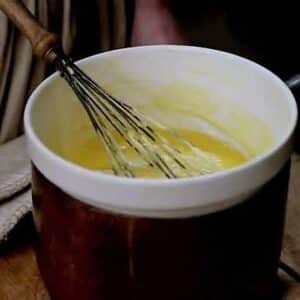
Feuilletés simply means puff paste in French. The English are the first to claim they grow the best asparagus so it is not surprising that it pops up on English menus, particularly in May and June when it is fresh off the fields. Once called ‘sparrow-grass’, but now affectionately known in the trade as simply ‘grass’.
There is really not much involved in the dish. If you can cut rectangles and trim asparagus, you are practically there. It is a little labour intensive which is why Mrs. Patmore would delegate it to a junior like Ivy.
Downton's Appetising Asparagus Feuilletés
Feuilletés simply means puff paste in French. The English are the first to claim they grow the best asparagus. Once called ‘sparrow-grass’, but now affectionately known in the trade as simply ‘grass’.
There is really not much involved in the dish. If you can cut rectangles and trim asparagus, you are practically there. It is a little labour intensive which is why Mrs. Patmore would delegate it to a junior like Ivy. Feuilletés simply means puff paste in French.
Ingredients
- 1- 2 sheets puff pastry* (thawed)
- 2 large egg yolks lightly beaten with 2 tbsp. of water
- 2 tbsp. finely grated parmesan cheese (optional)
Instructions
- Unfold the thawed pastry sheet and cut in half. Lightly flour your working surface and roll out each half with a floured rolling pin until it is half the original thickness.
- Use a pastry brush to dust off the excess flour on both sides of the pastry then trim the edges with a ruler and knife to even out the dough.
- Cut crosswise into 12 (6.25" tall x 3"wide) rectangles.
- Brush rectangles with some egg wash. Place a spear on one rectangle, sprinkle with a little cheese if using, and then place another on top, pressing the edges to seal in like a pocket.
- Arrange 1 inch apart on lightly oiled baking sheets and brush top with egg wash. Chill for 15 minute until pastry is firm.
- Preheat oven to 400°F.
- Bake pockets in middle of oven until puffed and golden, about 16 minutes.
- Transfer with to a cutting board and cut into 1 -2? wedges or leave whole to dip.
- Serve warm with the hollandaise sauce (recipe below).
Notes
Easy Peasy Hollandaise, the Mother of Sauces
Every cook should be able to make classic French Mother sauces and hollandaise is one of the great ones, perfect for asparagus, fish and American favourite Eggs Benedict. It had a cameo role on Downton, but who knew it was always keto friendly.
This version created by Master Chef Auguste Escoffier, who inventedthe 5 mother sauces, set the standard for all us to follow.
Ingredients
- 1 tbsp. white vinegar
- 1 tbsp water
- 2 large egg yolks
- 1 cup clarified butter*
- 1/2 medium lemon, juiced to thin the sauce if required
- 1 pinch cayenne pepper, to taste
- 1/4 tsp. salt to taste
Instructions
- Make the Clarified Butter by melting the butter over low heat in a heavy saucepan. Remove the pan from the heat and let stand for 5 minutes. Skim the foam from the top, and slowly pour into a container, discarding the milky solids in the bottom of pan.
- Place yolks, water and vinegar in a metal bowl, whisking until incorporated.
- Place the bowl on a pot of simmering water, and quickly whisk until yolks are lighter in color and a ribbon consistency, then remove from heat.
- Heat clarified butter to 125 F (warm, not hot).
- Slowly add butter to yolks, whisking constantly. Add a few drops of lemon juice to thin the sauce if you need to. Season to taste with salt, cayenne and lemon juice.
- You can hold the sauce at 125F for 1.5 hours. The best way to keep it warm is by putting over a pan of lukewarm water, it will hold perfectly. Too warm and it will curdle.
Notes
Hollandaise Fixes
- If the Sauce is too Thick: beat in 1 to 2 tablespoons of hot water, vegetable cooking liquid, stock, milk, or cream.
- If the Sauce Refuses to Thicken: if you have beaten in your butter too quickly, and the sauce refuses to thicken, rinse out a mixing bowl with hot water. Put in a teaspoon of lemon juice and a tablespoon of the sauce. Whisk for a moment until the sauce creams and thickens. Then whisk in the rest of the sauce half a tablespoon at a time, beating until each addition has thickened in the sauce before adding the next. Your patience will be rewarded.
- The Downton Cure when the Sauce has Broken or "Curdled: if a finished sauce starts to separate, a tablespoon of cold water beaten into it will often bring it back. If that fails, whisk another egg in a separate heated bowl, and then slowly whisk in the curdled sauce.
- Leftover Hollandaise: you can keep leftover hollandaise for a day or two refrigerated but freezes great. You can add it to other sauces as well to enhance flavour. To reheat, whisk a couple of tablespoons over very low heat or over another pot of simmering water, then gradually whisk in the remaining sauce.
Tried this recipe?Let us know how it was!
Tried this recipe?Let us know how it was!


